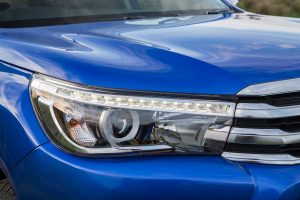
After 47 years of badge life and over a decade long model run, the mighty Toyota HiLux has been given a major update with a host of big changes for the popular workhorse. Gone is the love-it-or-hate-it 3.0L turbo-diesel, in its place is the 1GD-FTV, a 2.8L common-rail injection four-cylinder with a variable-vane turbocharger and intercooler that reportedly puts out 130kW and 450NM of torque. The 2×4 models have a slightly smaller 2.4L CRD with less power and 50 fewer NM although both claim a 10% increase in fuel economy. The four-cylinder 2.7L petrol motor has been given a few extra ponies and gone through a weight-loss program while the 4.0L V6 remains unchanged.

The engines are mated to either a 6-speed auto or 6-speed manual that features ‘intelligent’ technology that matches engine and transmission revs to reduce shock loads on the drivetrain and reduce the likelihood of stalling when towing.

The body also receives a complete makeover with a bigger ute tub, more interior space, 70mm more length, 20mm of extra width and a lower roof line to aid in overall stability. LED daytime running lights augment the headlights, which also utilise low-power draw high output LED technology. The grille has been brought into line to match up with other SUV models in the Toyota range while the rims come in 16in, 17in and 18in flavours and are shod in A/T tyres on the 4×4 models.

The fuel tank has been bumped up in capacity to 80L while the vehicle sports a thicker chassis that allows for the healthy 3500kg towing capacity and up to 1240kg payload capacity. The suspension is largely unchanged with the same double a-arm with coilover front end and leaf spring solid axle rear, although there are now thicker shocks to soak up the bumps with less chance of fade over rougher tracks. The brakes are (disappointingly) still drums in the rear and discs up front which are unchanged from the previous model.

Toyota has reportedly put in a lot of effort to reducing the noise, vibration and harshness (NVH) levels with greater sound deadening properties, and the handling dynamics and body rigidity have also been improved with more spot welds and higher grade, yet lighter, steel panels used throughout the cab. Thinner seat backs and the larger dimensions have freed up more interior space and the SR5 models come standard with a reverse camera mounted in the tailgate and nifty gadgets like keyless start and touch-screen multi-media displays.

So with a stronger frame, more powerful and efficient turbo-diesels, better interior and driveability and a more useable amount of space in the back, has the eighth generation HiLux finally perfected the off-road ute? Time will tell.
[socialpoll id=”2273084″]












